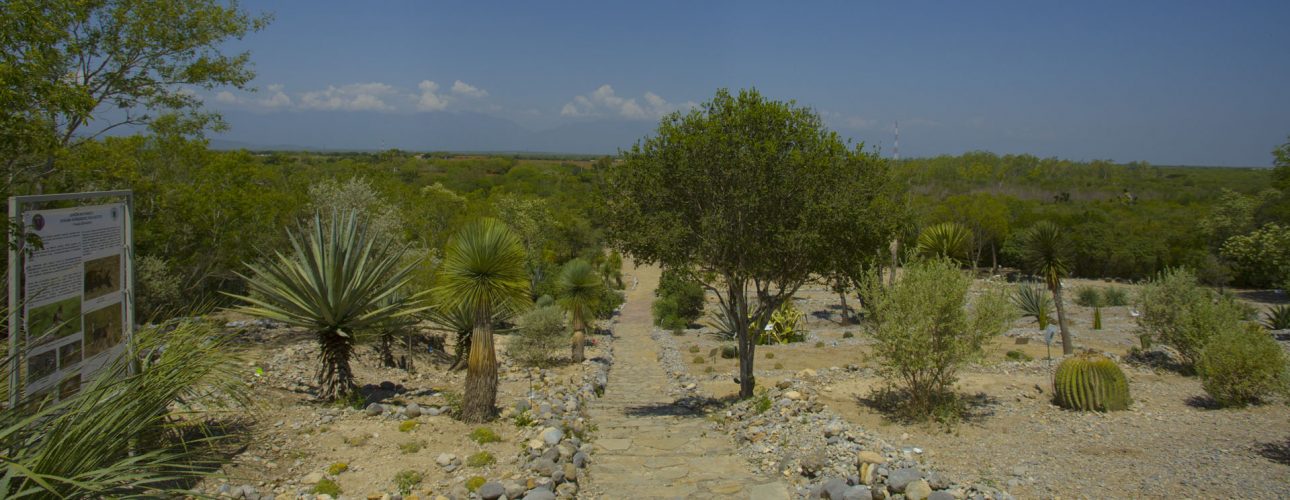Conservation and sustainable use of biodiversity and natural resources
Conservation and sustainable use of biodiversity and natural resources
“Efraím Hernández Xolocotzi” Botanical Garden
El Jardín Botánico “Efraím Hernández Xolocotzin (EHX)” de la Facultad de Ciencias Forestales de la Universidad Autónoma de Nuevo León constituye un espacio estratégico para la conservación, investigación y aprovechamiento sustentable de la biodiversidad de la flora, con especial énfasis en especies nativas y de valor ecológico para la región noreste de México. Su misión integra la preservación del patrimonio natural con la generación y difusión de conocimiento científico, sirviendo como plataforma para el desarrollo de proyectos de investigación aplicada, educación ambiental y restauración ecológica.
La actual colección del jardín botánico “EHX” cuenta con más de 60 mil plantas de más de 58 especies

Este programa ha fortalecido su papel como centro de resguardo y propagación de especies forestales de interés ecológico, ornamental y productivo, contribuyendo a la recuperación de ecosistemas degradados y al cumplimiento de los objetivos institucionales de sustentabilidad. Además, el Jardín Botánico promueve la vinculación con comunidades, instituciones y organismos especializados, impulsando acciones colaborativas que favorecen la resiliencia ambiental y el uso responsable de los recursos naturales.
En este apartado se presentan los principales avances, resultados y acciones realizadas durante el año 2024, reflejando 119 el compromiso de la UANL con la conservación de la biodiversidad y el fortalecimiento de la cultura ambiental.
Durante el año 2024, dentro de la estrategia de preservación de especies vegetales, se realizó la recolección de más de 150,000 semillas de 6 especies (Amoreuxia wrightii, Dasylirion berlandieri, Ferocactus echidne, Mammillaria compressa, Thelocactus hexaedrophorus y Thelocactus tulensis).
En 2024 se realizó la recolección de más de 1650 mil semillas de especies de interés ecológico.
Wildlife monitoring
En el año 2024, se realizó el registro de más de 60 especies de vertebrados terrestres, de las cuales, 11 se encuentran en alguna categoría de riesgo de extinción, según la NOM-059-SEMARNAT-2010, entre los que destacan el ocelote (Leopardus pardalis), sapo excavador mexicano (Rhinophrynus dorsalis), pato mexicano (Anas diazi) y la víbora de cascabel de diamantes (Crotalus atrox).
Durante el 2024 se realizó el registro de más de 60 especies de vertebrados terrestres, de las cuales, 11 se encuentran en alguna categoría de riesgo de extinción.
Programa de educación ambiental
El programa de Educación Ambiental tiene como propósito fomentar la conciencia y el compromiso con la conservación de la biodiversidad y el uso responsable de los recursos naturales. A través de actividades didácticas, recorridos guiados, talleres y proyectos colaborativos, se promueve el aprendizaje vivencial y la participación de estudiantes, docentes y visitantes. Este esfuerzo fortalece la cultura ambiental universitaria y contribuye al cumplimiento de los objetivos institucionales en materia de sustentabilidad.
Recorridos guiados: se atendieron seis planteles educativos y un aproximado de 350 niños y 25 profesores, a quienes se les impartieron presentaciones relacionadas a la conservación de la biodiversidad en el auditorio principal de la FCF-UANL, para posteriormente realizar un recorrido por el jardín botánico y mostrarles el acervo biológico con el que se cuenta, haciendo un énfasis en aquellas especies que presentan un estatus de conservación de acuerdo a la NOM-059-SEMARNAT-2010, finalmente se realizaron actividades didácticas dentro del Centro de Atención a Visitantes.
Talleres ambientales: esta actividad se realizó en escuelas de comunidades urbanas, rurales y grupos subrepresentados, en las que se realizó la impartición de talleres de germinación, manejo de residuos, identificación de huellas de fauna silvestre y técnicas de monitoreo de fauna silvestre. En total se atendieron más de 2,000 personas en los distintos talleres que se llevaron a cabo.
Feria ambiental: se realizó una feria ambiental en conjunto con la Unidad Regional 7 de la Secretaría de Educación del estado de N.L. y el municipio de Linares, N.L., las actividades llevadas a cabo en esta feria ambiental estuvieron enfocadas a grupos vulnerables como lo son escuelas rurales de escasos recursos e instituciones de educación especial; así como a público en general. El objetivo principal de esta actividad fue brindar las herramientas adecuadas para el uso y manejo sostenible de los recursos naturales, a través de talleres sobre germinación de plantas nativas, manejo de residuos y técnicas de monitoreo de fauna silvestre, así como exposiciones audiovisuales de la biodiversidad de la región y de dibujos y frases realizadas por alumnos de escuelas primarias participantes en los últimos dos concursos realizados por el jardín botánico. Al final de la feria ambiental se atendieron más de 800 personas.
Más de 3,200 personas participaron en las distintas acciones de educación ambiental promovidas por el Jardín Bótanico EHX.
Redes Sociales
El jardín botánico cuenta con redes sociales mediante las cuales se realizaron más de 200 publicaciones (Posts, cápsulas, podcast, reels, actividades del jardín, etc.), dirigidas al público especializado y no especializado. La difusión a través de estos medios ha sido un factor importante para la expansión del conocimiento, ya que a través de ellas se han hecho publicaciones relacionadas a la conservación de la biodiversidad, saberes tradicionales y otros materiales de tópicos ambientales. Esta información fue divulgada a más de 20,000 personas que son los seguidores de las páginas institucionales y de alianzas estratégicas. A continuación, se mencionan algunas de las secciones manejadas en las redes sociales institucionales del jardín botánico.
Museo virtual del jardín botánico:
dentro de las publicaciones realizadas en las redes sociales destaca un museo virtual, el cual consiste en cápsulas informativas sobre la biodiversidad y tópicos ambientales.

Podcast del jardín botánico

Como parte de la estrategia de divulgación de actividades y conservación de la biodiversidad, se realizaron dos podcasts; el primero abordó el tema de: manejo de residuos peligrosos y no peligrosos en la comunidad y centros educativos. El segundo contempló el tema de los jardines botánicos y su importancia. Cabe destacar que ambos podcasts tienen una hora de duración y de cada uno se obtuvieron cápsulas de temas ambientales muy específicos que fueron difundidos mediante las redes sociales institucionales, de igual manera, se compartieron tópicos sobre los podcasts: Los cambios de uso de suelo en terrenos forestales y Los estudios de impacto ambiental en el ámbito del estado de Nuevo León.
Durante el año 2024 se realizaron 167 publicaciones; de actividades realizadas continuamente en el jardín botánico (educación ambiental, mantenimiento, fenología, etc.), sobre la importancia biocultural de especies de flora, fauna, hongos, insectos, etc., así como de diversos tópicos ambientales (cadena alimenticia, camuflaje, fotosíntesis, fenología, etc.) a través de Facebook, X, Instagram, Linkedin, TikTok y Youtube.
Acervo Bibliográfico
En el año 2024, se elaboraron guías de campo de especies de flora y fauna silvestre del jardín, así como catálogos de plantas y semillas de las plantas rescatadas. A continuación, se mencionan los trabajos realizados:
Guía de campo de las principales especies vegetales arbóreas, arbustivas y herbáceas del matorral espinoso tamaulipeco: se elaboró una guía de las principales especies arbóreas, arbustivas y herbáceas del jardín. Dicha guía cuenta con un contenido de más de 30 especies y se describe su morfología, usos, distribución y estatus de conservación nacionales e internacionales.
Guía de campo de aves presentes en el JB: se desarrolló el contenido descriptivo mediante una guía de campo que incluye más de 40 especies de aves del jardín botánico. El contenido de la guía presenta la clasificación de las especies por orden y familia, así como su descripción, distribución, mitos, etc.
Manual de huellas de especies faunísticas:
se elaboró una guía sobre técnicas de colecta de huellas de fauna silvestre, en la que se describen diversas metodologías y técnicas para la colecta de huellas en moldes de yeso.
Guía de campo de especies vegetales en riesgo de extinción: se realizó una guía de campo de las 18 especies de flora presentes en el jardín botánico en categoría de riesgo de extinción según la Norma Oficial Mexicana 059. La guía está dirigida a público especializado y no especializado, contiene taxonomía, estatus de conservación nacional e internacional, descripción, distribución, usos, amenazas y acciones de conservación.
Guía de flores de especies de cactáceas (Parte 2): esta guía muestra las principales cactáceas con flores presentes en el jardín y expone elementos básicos sobre las especies, principalmente fotografías que muestran sus estadios reproductivos (crecimiento, botón floral, flor, fruto, etc.) así como un fenograma que muestra los periodos en que ocurren dichos estadios.
Catálogo de semillas colectadas de especies del matorral xerófilo: se realizó en un catálogo que muestra la morfología de las semillas de 10 especies de flora colectadas. Además, proporciona una breve descripción botánica de la especie y su fruto, así como los usos de la planta, incluyendo recomendaciones para la germinación.
Reproducción de especies
Como parte de la estrategia de lograr la sustentabilidad del jardín botánico a largo plazo, se continuó con la producción de plantas en laboratorio y en el invernadero. Las plantas producidas se encuentran en el túnel de invernadero recibiendo los cuidados y condiciones adecuadas para su desarrollo y crecimiento. En total se reprodujeron 30,000 plantas de seis especies de cactáceas con las que se pretende incrementar el acervo biológico de especies vegetales mediante el intercambio de especímenes y especies con otros jardines, así como de realizar programas de adopción de plantas como parte de la estrategia de educación ambiental.
En 2024 se produjeron 30,000 plantas de 6 especies de cactáceas de alta importancia ecológica
Jardín Etnobiológico de la UANL
El Jardín Etnobiológico (JEB) de la UANL en 2024 realizó actividades de investigación y divulgación de la ciencia a través del proyecto nacional de Jardines Etnobiológicos de la Secretaría de Ciencia, Humanidades, Tecnología e Innovación (SECIHTI). Las actividades de sustentabilidad en el medio agropecuario se centraron en tres diferentes aspectos: capacitación a productores en el uso sustentable de recursos, detección de transgénicos a través de tiras reactivas en maíz y conservación ex situ de especies vegetales nativas.
a) Capacitación de productores en el uso sustentable de recursos.
Capacitaciones en diferentes aspectos de la producción agrícola con enfoque sustentable, entre los que se encuentran: producción de fertilizantes orgánicos como la lombricomposta, control biológico de plagas y conservación adecuada de la semilla.
b) Detección de transgénicos a través de tiras reactivas en maíz.
De acuerdo al número de importaciones de maíz desde los Estados Unidos de Norteamérica cada año, existe un riesgo latente de incrementar la contaminación del maíz nativo con maíces transgénicos importados. Aunque hay reportes de la presencia de transgenes en algunas poblaciones de maíz nativo en México, existen algunas zonas en donde la contaminación no se presenta y que es necesario conservar para evitar la pérdida de esa variabilidad genética original existente en todos los maíces nativos mexicanos.
La Facultad de Agronomía, Unidad Académica La Ascensión, organizó una capacitación a técnicos representantes de las oficinas gubernamentales estatales y federales, en el uso de tiras reactivas para detectar la presencia de transgenes. Estas tiras, reaccionan a la presencia de transgenes, dependiendo de la tira reactiva, con una muestra de hoja de las plantas de maíz.
c) Conservación ex situ de especies vegetales nativas.
La Facultad de Agronomía acondicionó un espacio con el propósito de mantener una colección de las especies vegetales representativas del sur de Nuevo León. Para ello se dispuso de 4.7 hectáreas dentro de la Unidad Académica La Ascensión. En esta superficie de terreno, se trazaron caminos, andadores, áreas para venta de platas y espacios para la distribución de las especies vegetales que se fueran a incluir en el jardín (Agaves, Pinos, Cactus, yucas, opuntias, etc.).
La Facultad de Agronomía de la UANL, realiza acciones para la sustentabilidad de los ecosistemas, como un aprovechamiento racional de los recursos y la definición de sistemas de producción agrícola más amigables con el ambiente. Para el 2025 y 2026, se tiene contemplado la creación del “Centro Estatal para el Desarrollo de una Agricultura Sustentable” con el objetivo de generar conocimiento para el uso de prácticas agrícolas sustentables, a través de la capacitación de productores, técnicos y estudiantes en el uso de la tecnología que permita aumentar la productividad de los agrosistemas y enfrentar los retos del cambio climático.
Sustentabilidad en los sistemas de producción agrícola con maíz
El maíz es el principal cultivo en superficie sembrada en Nuevo León con más de 60 mil hectáreas (Servicio de Información Agroalimentaria y Pesquera, 2022) en donde el 90 % de ellas está sembrada bajo condiciones de temporal utilizando maíces nativos. En estos sistemas de producción, los productores utilizan para sus siembras, semillas colectadas en el ciclo de cultivo previo, manteniendo una pureza varietal; sin embargo, debido a los efectos del cambio climático, la producción de semilla nativa se ha visto limitada y en muchas ocasiones nula por la falta de precipitación; con esto se ha perdido una riqueza genética invaluable representada a través de los maíces nativos.
Con la finalidad de evitar la pérdida total de las semillas de maíz nativo, la Facultad de Agronomía de la UANL, emprendió dos acciones principales para evitar un colapso en la siembra de maíz nativo en la región:
1) Colecta de semilla de maíces nativos para conservar esta variabilidad genética a través de un banco de germoplasma; actualmente se cuenta con más 60 tipos de maíces nativos, principalmente de la zona sur de N.L.
2) Multiplicación de semillas de los maíces nativos. Para ello, se seleccionaron tres maíces nativos de tres nichos ecológicos representativos del sur de NL, se colecto semilla de los agricultores locales y se sembraron en el Campo Experimental de la Unidad Académica La Ascensión de la Facultad de Agronomía, UANL en el ciclo PV 2024. De cada uno de los tres genotipos se pudo colectar aproximadamente 10 Kg de semilla y se sembraron en lotes aislados para evitar la contaminación de ellos. Al final del ciclo se produjeron casi 2.5 toneladas de semilla, las cuales fueron beneficiadas y encostaladas en la Universidad Autónoma Agraria Antonio Narro (UAAAN) a quienes agradecemos su apoyo.










